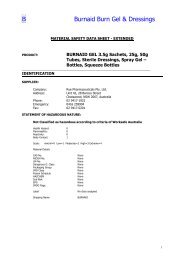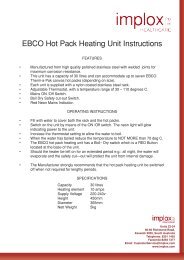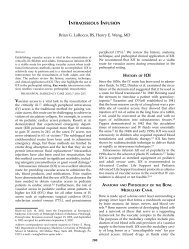Low and medium Frequency Electrotherapy - Implox
Low and medium Frequency Electrotherapy - Implox
Low and medium Frequency Electrotherapy - Implox
Create successful ePaper yourself
Turn your PDF publications into a flip-book with our unique Google optimized e-Paper software.
A lesion of the Aa motor neurons can lead to total or partial denervation of the associated muscles.<br />
In such cases, the appearance of the strength/duration curve is as follows:<br />
1. total denervation:<br />
If the whole of the rectangular pulse curve is shifted upwards <strong>and</strong> to the right, total denervation of the muscle or<br />
muscle group has occurred (due to lesion or rupture of the nerve).<br />
The triangular pulse curve will show that the accommodation ability has been lost. If curves measured over a period<br />
of time show a shift downwards <strong>and</strong> to the left, this indicates reinnervation of the muscle. The clinical recovery may<br />
sometimes be observed as much as six to eight weeks later.<br />
N.B. Degeneration of the nerve fibre cannot be prevented. Similarly, neither a rectangular nor a triangular pulse can<br />
accelerate the process of reinnervation.<br />
2. Partial denervation<br />
A kink in the triangular pulse curve is an indication of partial denervation. The characteristic kink is visible at relatively<br />
long phase times, <strong>and</strong> only with the triangular pulse. The rectangular pulse curve cannot be determined for the<br />
affected motor units, as the just perceptible contraction will be caused by the healthy units.<br />
4.3.2 Therapy<br />
The therapeutic objectives of muscle stimulation include counteracting atrophy <strong>and</strong> preventing fibrosis of the muscle<br />
tissue. The optimum phase time for this purpose is determined using data from the strength/duration curve. The<br />
phase time to be used is found at the lowest point of the triangular pulse curve (Fig. 30). The triangular pulse is<br />
chosen in order to achieve selective contraction of the denervated muscle fibres. The phase interval should be<br />
sufficient to allow the muscle to recover after the contraction (at least twice the phase time). The amplitude is<br />
increased from the motor stimulation level up to the limit of tolerance.<br />
Fig. 30.<br />
Derivation of the parameters for electrical stimulation in partial denervation.<br />
The maximum treatment time depends on the number of contractions required. The treatment is stopped if there are<br />
signs of fatigue in the muscle or muscle group. Electrical stimulation is only of value if there is a reasonable chance of<br />
re-innervation, as the ultimate objective of this type of treatment is optimalization of the muscle tissues that will be<br />
required to function normally at a later stage.<br />
4.4 Faradic current<br />
26<br />
4.4.1 Description of the current type<br />
As soon as the muscle or muscle group has a reasonable degree of innervation, multiple stimulation can be applied,<br />
supplemented by active (functional) exercise therapy.<br />
In multiple muscle stimulation a series of rectangular or triangular pulses are used which result in tetanic (continuous)<br />
contraction. The series of direct-current pulses is therefore referred to as tetanizing or (neo) faradic current. The<br />
original faradic current, as described by Faraday himself, is a very irregular low-frequency alternating current. Due to<br />
the high degree of irregularity, this current type was very soon modified, resulting in the (neo) faradic current types.<br />
The (neo) faradic current in general use is a ‘Reiz’ current consisting of a train of rectangular pulses with a phase<br />
duration of 1 ms <strong>and</strong> a phase interval of 19 ms, resulting in a frequency of 50 Hz. (Neo) faradic currents consisting of<br />
triangular pulses have no practical application.















